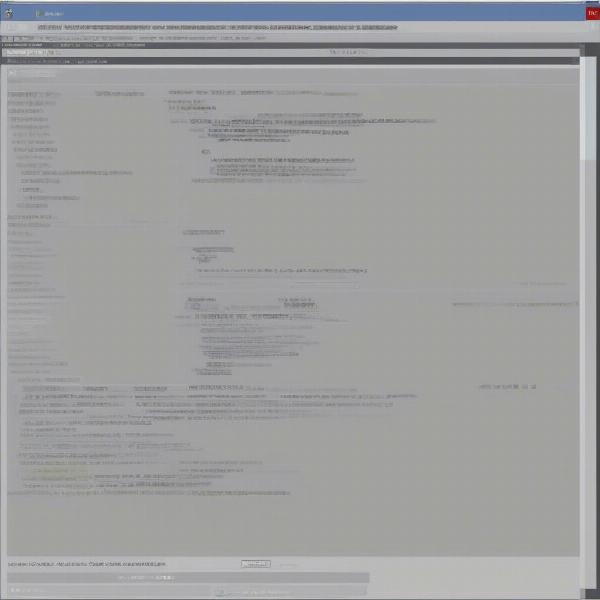Creating your own Roblox simulator can be a rewarding experience, allowing you to bring your unique game idea to life and share it with a massive online community. While it might seem daunting at first, breaking down the process into manageable steps makes it achievable for even beginner developers. This guide will walk you through everything you need to know about How To Make A Roblox Simulator Game, from initial concept to publishing your finished product.
Similar to finding what games to play when bored, creating a Roblox game can alleviate boredom and spark creativity. So, let’s dive in and uncover the secrets to crafting a successful Roblox simulator experience.
Conceptualizing Your Simulator
Before diving into Roblox Studio, the first crucial step is brainstorming and refining your simulator’s core concept. What will players be simulating? What makes your game unique and engaging? Consider popular simulator themes like tycoon, pet raising, or job simulation, and think about how you can add your own twist. Will it be a cooking simulator with exotic ingredients, a pet simulator with mythical creatures, or a tycoon game centered around building a space empire? Define your niche and target audience. A well-defined concept forms the foundation for a compelling and successful simulator.
Designing the Core Gameplay Loop
The gameplay loop is the heart of any simulator. It’s the cycle of actions players repeatedly perform, and it needs to be both rewarding and engaging to keep players coming back for more. For example, in a tycoon simulator, the loop might involve collecting resources, upgrading buildings, and earning profits. In a pet simulator, it might involve hatching eggs, caring for pets, and training them to perform tricks. Design a clear and satisfying loop that encourages players to invest time and effort in their virtual world. Remember, a compelling gameplay loop is key to retaining players.
Building Your World in Roblox Studio
With your concept and gameplay loop defined, it’s time to bring your simulator to life in Roblox Studio. Familiarize yourself with the interface and tools, experimenting with different terrain options, building structures, and adding interactive elements. Roblox Studio provides a user-friendly environment for creating even complex 3D worlds. Utilize the various tools and resources available within the platform to build a visually appealing and functional environment for your simulator. Don’t be afraid to experiment and iterate on your designs.
Implementing Game Mechanics with Lua Scripting
Lua scripting is the backbone of Roblox game development, allowing you to add functionality and interactivity to your simulator. Learn the basics of Lua and explore how to implement core mechanics like resource management, player progression, and in-game events. Start with simple scripts and gradually build your skills. Roblox offers a wealth of resources and tutorials to help you master Lua scripting and bring your game ideas to life. Don’t be intimidated by coding; there are many beginner-friendly resources available.
Monetization Strategies for Your Simulator
While creating a fun game is the primary goal, consider incorporating monetization strategies to support further development. In-app purchases for in-game currency, cosmetic items, or boosts can provide a sustainable revenue stream. Balance monetization with player experience; ensure that purchases enhance gameplay rather than creating a pay-to-win scenario. Think about creative and ethical ways to monetize your simulator without compromising the fun factor for your players. A balanced approach is essential for long-term success.
Testing and Refining Your Simulator
Thorough testing is crucial for identifying and fixing bugs, balancing gameplay, and ensuring a polished player experience. Enlist friends, family, or fellow developers to playtest your simulator and provide feedback. Pay close attention to their suggestions and iterate on your game based on their input. Testing is an ongoing process; even after launch, continue to gather player feedback and refine your simulator to provide the best possible experience.
Publishing and Marketing Your Roblox Simulator
Once your simulator is thoroughly tested and refined, it’s time to publish it to the Roblox platform. Create compelling game icons, thumbnails, and descriptions to attract players. Promote your game on social media, forums, and other online communities to reach a wider audience. Engage with your player base and actively respond to feedback. Building a strong community around your simulator is key to its long-term success. This mirrors the principles discussed in what games to play when bored about finding and connecting with gaming communities.
Advanced Simulator Development Techniques
Once you’re comfortable with the basics, explore advanced techniques like creating custom UI elements, implementing complex game mechanics, and optimizing performance for a smooth player experience. Continuously learning and expanding your skillset will allow you to create increasingly sophisticated and engaging simulators.
 Advanced Roblox Simulator Development
Advanced Roblox Simulator Development
Creating Engaging Events and Updates
Keep your players engaged by regularly introducing new content, events, and updates to your simulator. This could include seasonal events, limited-time challenges, or new gameplay features. Regular updates demonstrate your commitment to the game and provide players with fresh reasons to return to your simulator.
Building a Community Around Your Simulator
Foster a positive and active community around your simulator by engaging with players, responding to feedback, and creating opportunities for interaction. A thriving community can significantly contribute to the success of your game.
Conclusion
Creating a Roblox simulator game is a journey that combines creativity, technical skills, and a passion for game development. By following this guide and dedicating yourself to the process, you can bring your unique simulator idea to life and share it with the world. Remember, the key is to start simple, iterate based on feedback, and never stop learning. Now go forth and create the next big Roblox simulator hit!
FAQ
-
What is the easiest programming language to learn for Roblox? Lua is the scripting language used in Roblox, and it’s considered relatively beginner-friendly.
-
How long does it take to make a Roblox simulator? The development time varies depending on the complexity of the simulator. Simple simulators can be created in a few weeks, while more complex ones can take months or even years.
-
Can I make money from my Roblox simulator? Yes, you can monetize your simulator through in-app purchases, game passes, and other methods.
-
What are some popular Roblox simulator genres? Popular genres include tycoon simulators, pet simulators, and life simulators.
-
Do I need coding experience to make a Roblox simulator? While coding experience is helpful, it’s not strictly required. Roblox Studio provides user-friendly tools that allow beginners to get started.
-
What are some tips for designing a successful Roblox simulator? Focus on a clear gameplay loop, create engaging content, and actively engage with your player community.
-
Where can I find resources for learning Roblox development? Roblox offers numerous tutorials, documentation, and community forums to help developers of all skill levels.

